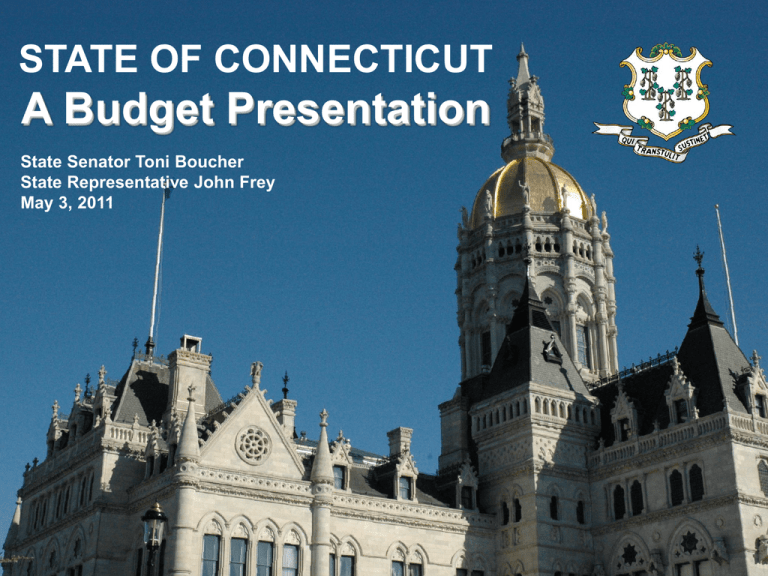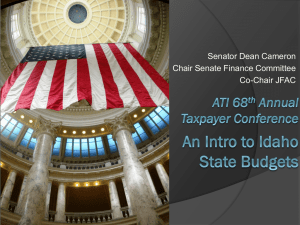PPT - Westport Republicans
advertisement

STATE OF CONNECTICUT A Budget Presentation State Senator Toni Boucher State Representative John Frey May 3, 2011 Legislature’s Budget Process (Governor Proposes, Legislature Decides) • • • • • • • • • • • • • 1 Connecticut Has a Biennial Budget Governor Submits Budget to Legislature in Odd Numbered Years Appropriations Committee Holds Hearings for Each State Agency Subcommittees Review Budget Information Subcommittees Report to the Appropriations Chairmen Appropriations Chairmen Prepare Budget Recommendations Budget Report Submitted to Full Appropriations Committee and Voted Upon Finance Committee Produces Revenue Estimates and Capital Budget Bills Appropriations and Finance Bills Submitted to House and Senate Alternative Budgets May Be Presented by Minority Party Legislative Leaders and Governor Negotiate Budget House and Senate Debate and Adopt Governor’s Signature or Veto (Returned to Legislature) State Government Has Grown Too Large Connecticut’s Population vs. Real State Government Expenditures (Source OFA & Census) 2 State Government Has Grown Too Large Connecticut’s Employment Growth vs. State Employment Growth (Source U.S. Census Bureau & CT Department of Labor) 3 Budget Deficit Projections FY 2011- FY 2013 General Fund (Source OPM) 4 Where Does The Money Come From? FY 2011 Revenue (Source: OFA) 5 Where Does Your Money Go? Major Spending Components for FY 2011 (Source: OFA) 6 The High Cost of Living and Doing Business in Connecticut • Nation’s highest total state and local taxes ($7,007) per capita • 2nd highest unfunded pension liability ($4,500) per capita • 4th highest state debt ($7,882) per capita • 45 states have fewer health insurance mandates • 2nd highest state gas taxes • Voted Least Business Friendly Legislature by Expansion Management magazine • 5th highest cost of doing business, according to the Milken Institute • 2nd highest electricity cost (after Hawaii) • Last Tax Freedom Day in the nation (May 2) • 9.0% unemployment, higher than the national average • 100,000 jobs lost during the recession Sources where not specified: US Census Bureau, the Internal Revenue Service, CT Dept. of Revenue Services, CT Dept. of Labor, Secretary of the State, The Tax Foundation, Education Sector, Tax Foundation & U.S. Dept. of Energy. 7 Closing The Budget Gap: What Makes Up Governor Malloy’s Proposed Solution? FY 2012 (General Fund) (Source: OFA) 8 Governor Malloy’s Budget Proposal: Largest Tax Increase In State History • • • • • • • • • • • • • Income tax increase across the board Reduce property tax credit Increase sales tax to 6.35% Increase gas & diesel taxes to 28¢/gallon Increase taxes on: hotel rooms, cigarettes, alcohol, insurance companies, real estate sales 20% corporation tax surcharge Tax corporations for income earned in other states Expand the death tax Increase motor vehicle registration fees Increase driver’s license fee Create $25 driver’s license renewal fee Property tax on boats and aircraft New taxes on: $3.8 billion Revenue Increases • • • • • • • • 9 pet grooming automotive storage “Amazon tax” packing and crating automobile road services and towing limousine services labor on small aircraft repair clothing and footwear under $50 • • • • • • • • non-prescription drugs manicures and pedicures airport valet parking cosmetic surgery yoga cloth and fabric luxury goods hazardous waste removal • • • • • • car rental admissions and dues electricity generation cabarets waste-to-energy facilities hospitals The Republican Alternative: The “No Tax Increase” Budget • No Tax Increases. Period. • Reduces spending by $1.5 Billion from the Governor’s plan • Preserve aid to cities and towns at current levels • No borrowing for day-to-day operations • Provides real efficiencies and workforce reductions • Fully restores the property tax credit for homeowners • Redirects Connecticut’s budget toward a more sustainable future 10 The “No Tax Increase” Budget Workforce Restructuring Real Consolidations of Agencies and Job Functions Consolidates 36 state agencies into 9, and eliminates 383 government positions Saves $18.9 million in FY12 and $27.6 million in FY13 Middle-Management Reductions Eliminate 1,380 duplicative managerial positions over the biennium Increase the ratio of manager-to-workers from 1:6 to 1:12 • Consistent with the recommendations of the Bipartisan Commission on Enhancing Agency Outcomes • Savings of $112 million in FY12 and $138 million in FY13 Eliminate Vacant Positions • Savings of $10.8 million over both years of the biennium Implement a Hard Hiring Freeze Eliminate Longevity Payments Labor Concessions • Per the Governor’s plan, $2 billion in savings over two years 11 The “No Tax Increase” Budget Common Sense Reforms Mandate Relief/Local Options Privatization • Binding arbitration reform • Riverview Hospital • Raise threshold for prevailing wage requirements • DMV – Registrations • Eliminate Race to the Top requirements • DOC – Prisoner Health Care • Delay in-school suspension requirements • DSS – Program Intake & Applications • Limit unemployment benefits for part-time workers • Option to raise cap on municipal fines to $250 • Eliminate or suspend teacher in-service training • Optional delay of conservation & development plans • Optional delay of revaluation • Eliminate bicycle access mandate • Permit red light cameras 12 • DEP – Parks Maintenance • Bradley International Airport Governor Malloy’s Budget Appropriations & Finance Committees Final Budget Republican Alternative Budget February 2011 April 2011 April 2011 $39.9 billion total spending $42.4 billion total spending $36.4 billion total spending $2.0 billion assumed labor concessions $2.0 billion assumed labor concessions $2.0 billion assumed labor concessions $3.9 billion tax and fee increases $3.8 billion tax and fee increases No Tax Increases Creates 5 new income tax brackets, raises all income tax rates Creates 5 new income tax brackets, raises all income tax rates No Tax Increases 3¢ gas tax increase 3¢ gas tax increase Caps petroleum gross receipts tax 10% corporation tax surcharge 20% corporation tax surcharge No Tax Increases Eliminates property tax credit Reduces property tax credit to $300 Keeps $500 property tax credit Eliminates 150 state jobs Eliminates 71 state jobs Eliminates 2,700 workers including 1,380 managers Funds 166 vacant positions (costing $10.8 million per year) Eliminates 114 vacant positions Eliminates 166 vacant positions, saving $10.8 million per year Consolidations eliminate 24 agencies, saving $9.0 million per year Consolidations eliminate 57 agencies saving $8.0 million per year Consolidations eliminate 27+ agencies, saving $18.9 million in FY 12 and $27.6 million in FY13 Preserves municipal aid at current level Preserves municipal aid at current level Preserves municipal aid at current level Keeps longevity pay for state employees (approx. $40.0 million/year cost) Keeps longevity pay for state employees (approx. $40.0 million/year cost) Eliminates longevity pay for state employees 13 Who Pays Connecticut’s Individual Income Tax? 6.8% of filers pay 50.7% of income taxes (Source: Dept. of Revenue Services ) 14 Questions? Please Contact Us State Senator Toni Boucher Legislative Office Building Room 3400 Hartford, CT 06106 800-842-1421 Toni.Boucher@cga.ct.gov www.SenatorBoucher.com State Representative John H. Frey Legislative Office Building Room 4200 Hartford, CT 06106 800-842-1423 John.Frey@housegop.ct.gov www.RepFrey.com 15











